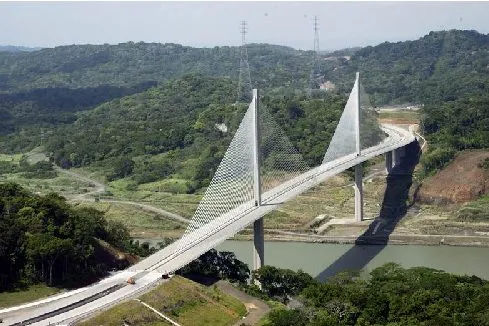Panama’s Ministry of Public Works is moving forward with a major 382 million dollar road expansion project targeting one of the country’s most critical traffic corridors. The initiative will widen and rehabilitate the approaches to the Centenario Bridge and the Panama–La Chorrera Highway under a 25-year Public–Private Partnership model. Officials approved the project’s pre-feasibility stage in October, authorizing the ministry to begin the formal bidding process for a contract that includes 30 months of construction followed by 21 years of private maintenance.
This ambitious plan represents the third major road infrastructure project Panama is developing using the public-private partnership framework. It specifically aims to alleviate severe congestion on the vital artery connecting Panama City to its western suburbs and the interior of the country. The project scope covers a total of 82 kilometers of roadway, with 38.5 kilometers dedicated to newly constructed lanes designed to increase capacity and improve traffic flow for thousands of daily commuters.
“The project will be executed by the Ministry of Public Works under the Public–Private Partnership model, through which the State will grant a concession for a third party to carry out the rehabilitation, expansion, and maintenance of the roadway,” [Translated from Spanish]
A detailed pre-feasibility report prepared by the International Finance Corporation provided the technical and financial groundwork for the government’s approval. The IFC, a member of the World Bank Group, analyzed the current road conditions, projected traffic patterns, and outlined the financial structure for the massive undertaking. Their involvement lends international credibility to the project’s planning phase and helps attract qualified international bidders.
Project Details and Innovative Traffic Solutions
Construction will focus on adding two new lanes to the Centenario Bridge access roads, one in each direction. The most innovative aspect involves the Panama–La Chorrera Highway, where engineers plan to build two reversible lanes. These lanes will change direction based on peak traffic flows, accommodating the morning rush into the capital and the evening exodus back to western communities. This dynamic system aims to maximize the efficiency of the existing roadway footprint.
The entire contract is structured over a quarter-century timeline. An initial 13-month pre-construction phase will be devoted to final technical studies and permit acquisition. The intensive construction phase is scheduled to last for 30 months. Once completed, the winning contractor will assume responsibility for maintaining the roads to strict government standards for the following 21 years. The maintenance portion also includes a segment of the Roberto F. Chiari road, known locally as the “8 lanes,” and the viaduct in the La Pesa sector.
“In the feasibility phase, a detailed analysis must be carried out on the impact that charging the user for access would have on traffic and its repercussion on the contractor’s remuneration, among other aspects related to the project,” [Translated from Spanish]
Tolling remains a point of consideration for the new reversible lanes. While the government has proposed charging for their use, the final decision will depend on the outcomes of the upcoming detailed feasibility studies. The IFC report explicitly states that analysts must carefully weigh the impact of tolls on overall traffic patterns and the financial returns for the private concessionaire. This analysis will determine whether the lanes operate as a premium, paid service or as part of the general highway infrastructure.
Accelerated Bidding and National Infrastructure Context
In a significant departure from similar projects, the Centenario and Chorrera highway contract will not include a pre-qualification stage for bidders. The Ministry of Public Works is deliberately streamlining the procurement process to accelerate the project’s start date. This move signals the administration’s urgency in addressing the region’s notorious traffic problems, which have worsened with continued urban growth west of the capital.
This project fits into a broader national strategy to leverage private investment for public infrastructure. If all three planned PPP road projects are successfully contracted, over 520 kilometers of Panamanian highways would be under private concession. The state would make fixed semi-annual payments to the concession holders to ensure the roads remain in optimal condition throughout the contract periods, transferring maintenance risk and long-term upkeep costs to the private sector.
The first of these partnerships, the rehabilitation and maintenance of the 246.2-kilometer Pan-American Highway segment between Pacora and Yaviza, is already under construction. That contract, awarded to the company ISA Vías through its subsidiary Ruta del Este, includes a 20-month rehabilitation phase followed by a 15-year maintenance concession. The second similar project, covering 192 kilometers from La Loma de Campana to Santiago, currently faces a temporary suspension after a bidder complaint was admitted by the Directorate General of Public Procurement.
Current Road Conditions and Immediate Next Steps
The IFC’s pre-feasibility study included a thorough diagnostic of the existing roads. It found that the Centenario Bridge approaches suffer from specific damage to the rigid pavement, including corner, longitudinal, and transverse cracks. The report also noted divided slabs, deteriorated seals, joint stepping, and spalling. Despite these issues, the overall surface condition allows vehicles to maintain speeds above 60 kilometers per hour, leading engineers to classify the roads as functional but in need of localized rehabilitation.
The Panama–La Chorrera Highway, built with flexible pavement, presented a different set of challenges that the full feasibility study will need to address in greater detail. The immediate next step for the Ministry of Public Works is to launch the phase two feasibility studies and the official international tender for the project. With the rector of the Public-Prature Partnership regime having already given the green light, ministry officials can now proceed with the detailed planning and contractor selection process, bringing this 382 million dollar solution one step closer to reality for Panama’s drivers.



